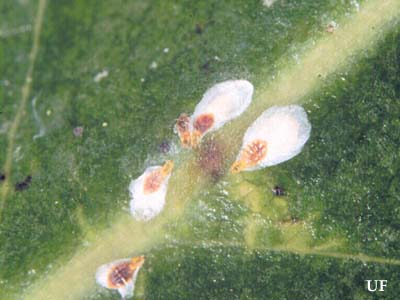
by Matthew Orwat | Jan 27, 2015

The magnolia white scale, Phenacaspis cockerelli, is also called false oleander scale. Image credit http://entomology.ifas.ufl.edu/creatures/orn/scales/false_oleander_scale.htm
Many fruit and ornamental shrubs and trees suffer from scale insects throughout the year. Most of the time home gardeners notice these insects in the spring or summer, because their exudate is the primary substrate for sooty mold growth. Although it seems counter-intuitive, the best time to control scale insects is in late winter. This can be achieved with one or two applications of horticultural oil, often called “dormant oil” in late January and early February.
Horticultural oil has been in use for well over one hundred years. While first only available in dormant oil formulations, it is now available in several types that allow for near year round application. Winter or “dormant” oils are heavier in weight, so they take longer to dissipate. Therefore, they cover pests for longer periods of time and are highly effective. All-season oils are purer, lighter and mixed with an emulsifier. This ensures that it will mix with water well and not damage the plant when exposed to warm, high-light conditions.
Horticultural oils are effective on soft-bodied insects and their eggs. Although scale insects often have a hard outer covering, they are considered soft-bodied. In addition to scale, mealybugs, aphids and spider mites are affected. These oils work primarily by smothering the insect and/or their eggs. Thus when oils are used, they block the insect’s ability to breathe.
Dormant oil is not a cure-all. It does not last very long, therefore the insect must be present for it to work. Additionally, it may kill beneficial insect eggs, so only use when a pest is present and do not apply to areas where infestations are not known. Make sure to cover the underside of the leaves and stems with spray.
Before applying dormant oils read the product label carefully. Any sensitive plants will be listed and temperature limitations will be noted.
Dormant oil is commonly used to control pests on these plants:
- Fruit trees in the Rosaceae (Pear, Apple, Peach, Plum, Nectarine, Blackberry)
- Roses
- Camellia (when not in bloom)
- Magnolia
- Gardenia
- Blueberry
- Crapemyrtle
- Dogwood
- Citrus
- Many others
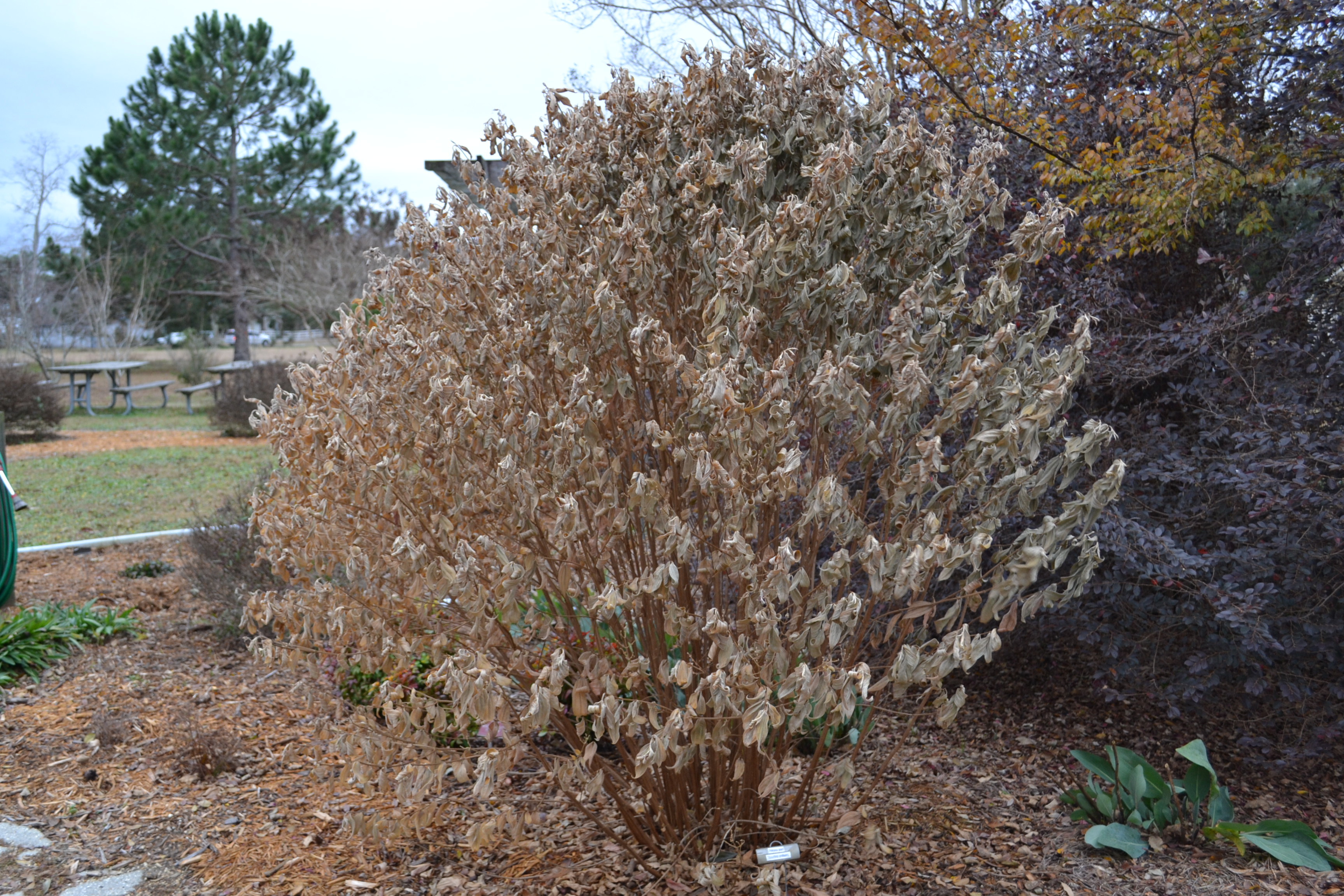
by Beth Bolles | Dec 2, 2014
Our recent cold weather was not only a surprise for many locals but also for many plants that still had plenty of green growth. After a couple of nights of freezing temperatures, even deciduous trees that had not dropped their leaves, look a little ratty.
Since it is just the beginning of December and we are likely to have many more days this winter with cold weather, now is not the time to react to plants that were damaged. There are a few exceptions of plants that you can prune back, but in general patience is the key for the winter garden and cold-damaged plants.
Here are a few guidelines.
Unless planted in very protected spots, annuals like coleus and angelonia were killed by recent cold air. You may remove these plants or cut them back close to the group to make garden areas look neater. You may want to add some new winter annuals to brighten up these spots.
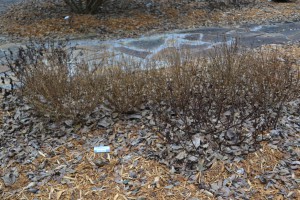
Warm season annuals can be removed from the garden.
Both young and mature citrus trees experienced injury since many plants still had tender growth. Do not prune out any damage at this time. We will wait until next Spring to learn where the growth will resume and then prune as necessary to remove dead branches.
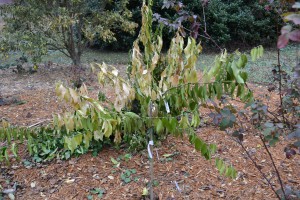
The tender growth on a young Meyer lemon was damaged by cold air.
As expected, the above ground portions of flowering perennials were severely injured by cold air. It is best not to prune these back now since the layer of branches and foliage may help insulate lower branches that could still have some life. If you are not able to tolerate the look of cold-damaged perennials in your garden, consider only pruning half of the plant just to make a neater appearance in the garden. When warm weather returns next year, we may be surprised to see growth resume on lower stems.
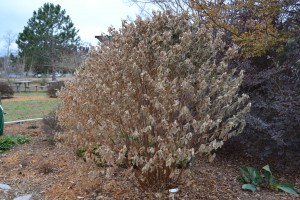
Many flowering perennials like Tibouchina will return from the ground next year.
Deciduous trees that would have normally dropped leaves before the cold have full canopies of dead leaves. Trees will eventually drop these leaves aided by winter winds and rainfall.
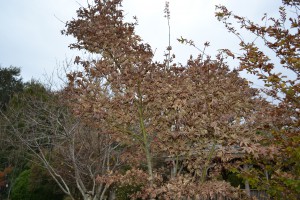
This Japanese maple will eventually drop it’s cold-damaged leaves and offer attractive bark and structure in the winter garden.
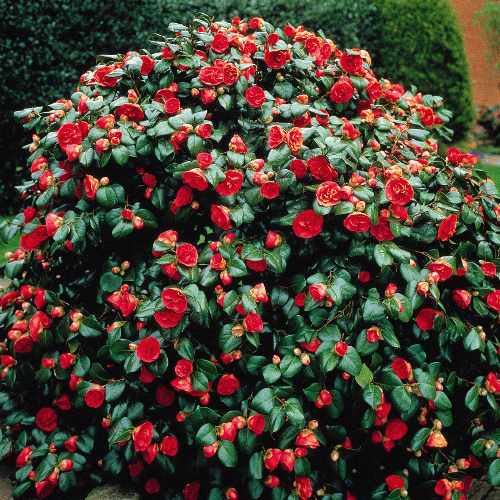
by Sheila Dunning | Dec 2, 2014
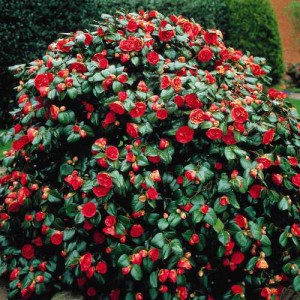 Camellias have been a part of the landscape in the Southeastern United States for over 200 years. They are native to Asia and were introduced near Charleston, South Carolina in 1786. The common name camellia refers to varieties and hybrids of Camellia japonica and to lesser known varieties of C. sasanqua and C. reticulata. The growing conditions in Northwest Florida are well suited for many camellia varieties. Camellias can serve several functions in the landscape including foundation plantings, screens, accent plants, background groupings and hedges. Maximum benefit can be achieved by mass plantings or groupings. Single plants should be focal point in beds rather than randomly placed throughout the lawn. Camellias flower in the fall and winter when their display of colorful blooms is most appreciated. During the remainder of the year their evergreen foliage, interesting shapes and textures, and relatively slow growth make camellias excellent landscape plants. Some camellia growers enjoy competing in flower shows and manipulate the flower buds to achieve larger and earlier flowers. This involves removing competing flower buds and applying gibberellic acid (a plant hormone). Individual cultivars can be selected for size and form ranging from small and irregular to large and upright. Texture and foliage color also differ among the various species and multiple varieties. Mid-season flowering varieties that bloom from November through January are best suited for Florida conditions.
Camellias have been a part of the landscape in the Southeastern United States for over 200 years. They are native to Asia and were introduced near Charleston, South Carolina in 1786. The common name camellia refers to varieties and hybrids of Camellia japonica and to lesser known varieties of C. sasanqua and C. reticulata. The growing conditions in Northwest Florida are well suited for many camellia varieties. Camellias can serve several functions in the landscape including foundation plantings, screens, accent plants, background groupings and hedges. Maximum benefit can be achieved by mass plantings or groupings. Single plants should be focal point in beds rather than randomly placed throughout the lawn. Camellias flower in the fall and winter when their display of colorful blooms is most appreciated. During the remainder of the year their evergreen foliage, interesting shapes and textures, and relatively slow growth make camellias excellent landscape plants. Some camellia growers enjoy competing in flower shows and manipulate the flower buds to achieve larger and earlier flowers. This involves removing competing flower buds and applying gibberellic acid (a plant hormone). Individual cultivars can be selected for size and form ranging from small and irregular to large and upright. Texture and foliage color also differ among the various species and multiple varieties. Mid-season flowering varieties that bloom from November through January are best suited for Florida conditions.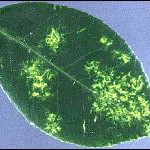
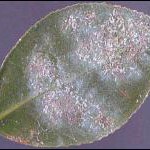 Warm fall temperatures may prevent early varieties from flowering properly. Late-blooming selections may attempt to send out new leaves before the end of the flowering period which results in “bullnoses”. Bullnosing is characterized by poor quality flowers which do not open fully and may even drop while still tight buds. Extended dry periods while in the bud stage can make the condition more likely. While flowering, camellias need 1 inch of water applied each week. Camellias perform best in partially shaded locations which are enhanced by good drainage and air movement. Fertile, acidic soils high in organic matter are preferred. The soil must be well-drained because camellias will not grow in wet areas. Do not plant them in areas with a high water table and/or hard-pan. This will result in a shallow root system which is more susceptible to injury during dry periods. Camellias should be installed where cold air can move in and out freely, but the area should be protected from strong northwest winds. Plantings under established trees or in areas that has structures to block the wind are usually injured less by cold temperatures. These conditions enable the plants to gradually thaw or warm in the morning before being exposed to direct sunlight. Dense shade may result in sparse foliage and poor flowering. Camellias exposed to full sun may appear yellow-green, but may yield more flowers. Either situation is stressful to the plants and can lead to pest problems. Tea scale is the most common insect on camellias. Scales generally feed on the underside of leaves and may not be noticed until large populations have developed. Symptoms include very small elongated white and/or brown raised “flakes” on the underside of leaves that turn yellowish in color. Tea scale can be controlled with horticultural oil, sprayed after flowering finishes but while temperatures are sill cool, in late winter.
Warm fall temperatures may prevent early varieties from flowering properly. Late-blooming selections may attempt to send out new leaves before the end of the flowering period which results in “bullnoses”. Bullnosing is characterized by poor quality flowers which do not open fully and may even drop while still tight buds. Extended dry periods while in the bud stage can make the condition more likely. While flowering, camellias need 1 inch of water applied each week. Camellias perform best in partially shaded locations which are enhanced by good drainage and air movement. Fertile, acidic soils high in organic matter are preferred. The soil must be well-drained because camellias will not grow in wet areas. Do not plant them in areas with a high water table and/or hard-pan. This will result in a shallow root system which is more susceptible to injury during dry periods. Camellias should be installed where cold air can move in and out freely, but the area should be protected from strong northwest winds. Plantings under established trees or in areas that has structures to block the wind are usually injured less by cold temperatures. These conditions enable the plants to gradually thaw or warm in the morning before being exposed to direct sunlight. Dense shade may result in sparse foliage and poor flowering. Camellias exposed to full sun may appear yellow-green, but may yield more flowers. Either situation is stressful to the plants and can lead to pest problems. Tea scale is the most common insect on camellias. Scales generally feed on the underside of leaves and may not be noticed until large populations have developed. Symptoms include very small elongated white and/or brown raised “flakes” on the underside of leaves that turn yellowish in color. Tea scale can be controlled with horticultural oil, sprayed after flowering finishes but while temperatures are sill cool, in late winter.
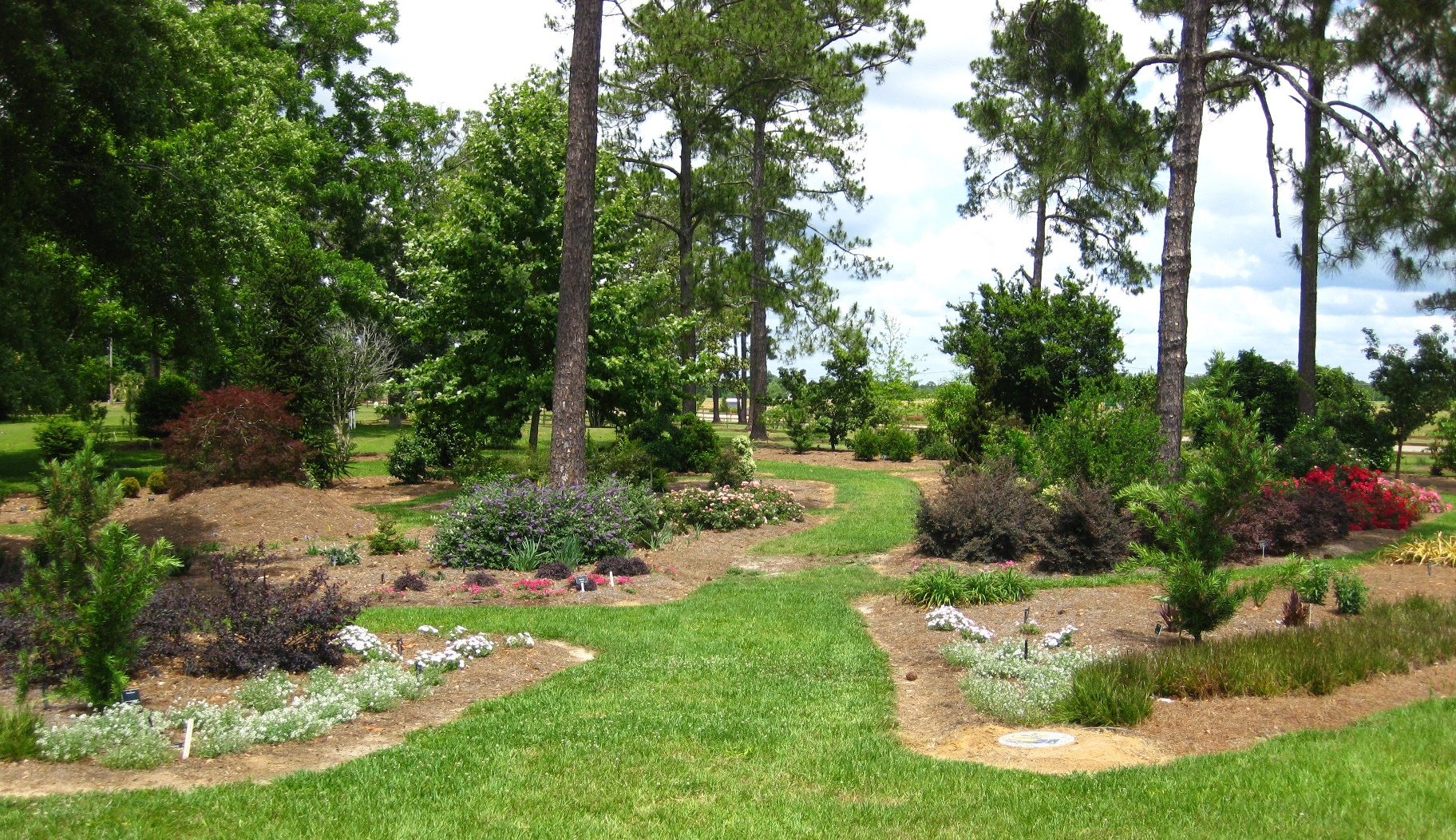
by Gary Knox | Nov 25, 2014

View of the Discovery Garden in Gardens of the Big Bend.
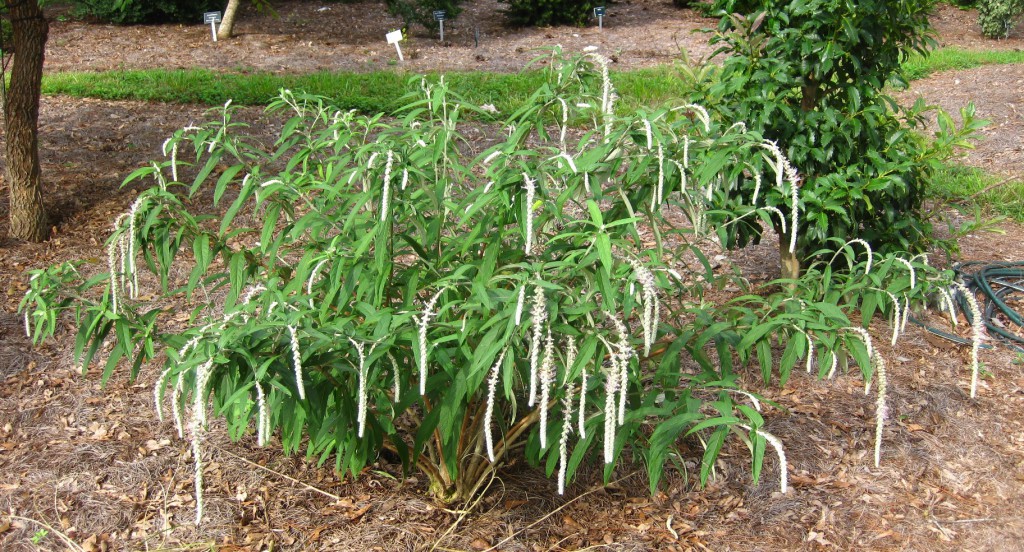
Weeping false butterflybush, Rostrinucula dependens, is a new and unusual perennial being evaluated in Gardens of the Big Bend.
Gardens of the Big Bend is a new botanical and teaching garden located on the grounds of the University of Florida/IFAS North Florida Research and Education Center in Quincy. The goals of these gardens are to evaluate new plants, promote garden plants adapted to the region, demonstrate environmentally sound principles of landscaping and provide a beautiful and educational environment for students, visitors, gardeners and Green Industry professionals.Located just 10 miles south of the Georgia-Florida border in Florida’s “Big Bend,” the Gardens are in USDA Cold Hardiness Zone 8b and have sandy-clay soils more typical of continental conditions than those of peninsular Florida.
Gardens of the Big Bend is a series of gardens, each with a theme or plant focus:
- The Discovery Garden contains over 170 species or cultivars of new, improved or underutilized trees, shrubs and perennials. The garden’s purpose is to help gardeners, landscapers and nursery growers “discover” new plants.
- The Magnolia Garden is part of the National Collection of Magnolia in recognition of its’ more than 200 species and cultivars, including some of the rarest magnolias in the world.
- The Crapemyrtle Garden includes six species and over 100 cultivars.
- Conifers can be found throughout the Gardens but are featured in the new “Jurassic” garden. More than just pines and junipers, the Gardens contain over 50 conifer species and cultivars, many of which are rare. In recognition, the American Conifer Society has designated the Gardens as a “Conifer Reference Garden”, the only one in Florida, and the southernmost in the U.S.
- The Dry Garden is the newest addition and contains about 140 different types of agave, aloe, cactus, dyckia, sedum, yucca, bulbs and other dry-adapted plants. It consists of a south-facing berm of boulders, gravel and sand about 160 feet long, 35 feet wide and 6 feet tall.
- Other gardens feature native, shade, Southern heritage, and weeping plants as well as collections of Japanese hydrangea and shrub roses. Additional gardens will be installed as time and funding permit.
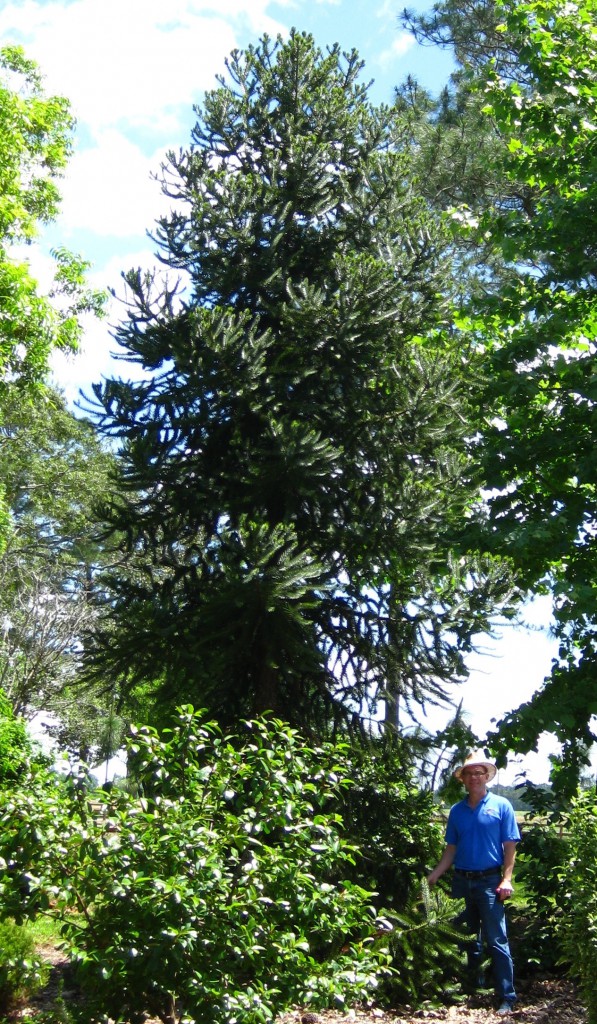
Parana pine, Araucaria angustifolia, is a rare type of conifer in the Gardens.
Gardens of the Big Bend formally began in 2008 thanks to the happy marriage of a new volunteer organization coupled with this University of Florida off-campus facility and plant collections I developed as part of research and extension projects. The volunteer organization, Gardening Friends of the Big Bend, Inc., formed in 2007 to support horticulture research and education. This group quickly seized on the idea of transplanting these existing plant collections into a series of gardens. Accordingly, its members hold fundraisers, provide volunteer labor and sponsor extension programs to raise awareness, provide funds and support garden development and maintenance.
Gardens of the Big Bend is located in Quincy at I-10 Exit 181, just 1/8 mile north on Pat Thomas Highway (SR 267). The gardens are free and open to the public during daylight hours year-round; professional staff are only available during normal business hours. To make a gift to the Gardens, please go to this website! Come visit us and watch the Gardens grow!

by Mary Salinas | Oct 21, 2014
This autumn you may notice shrubs with long, arching branches sporting clusters of shiny purple berries. That beautiful sight is the Beautyberry, or Callicarpa americana. This native is found throughout Florida and the southern United States, west into Texas and north to Tennessee and Virginia.
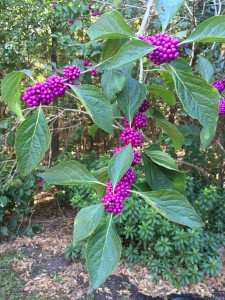
Beautyberry in the fall. Photo credit: Mary Derrick, UF IFAS Extension.
In the spring, lavender flowers adorn the branches and are a favorite of bees. The flowers eventually give way to the shiny purple berries in the fall. Birds find the berries very attractive and will feast on them when found. Mockingbirds and cardinals are especially fond of them. If you plant this shrub for the birds, one or two plants will provide more than enough of the berries to satisfy their appetites.
Beautyberry is adaptable to a wide variety of soils and moisture. After it gets established it is drought tolerant, however it can also do well in a moist area. A spot in your garden that gets partial sun is a perfect location. Plants in too much sun sometimes get a bit yellow and those in too much shade get leggy and don’t set as much fruit. Beautyberry is deciduous, meaning that it will lose all its leaves in the winter. Therefore, you may want to place it in an area of your yard where it won’t be a focal point in the winter.
This lovely plant is usually readily available at independent nurseries. If you prefer to grow your own, beautyberry is easy to propagate and grows rapidly. Snip off an approximate 6-inch piece from the end of a stem; the cut piece should have 5 sets of leaves. Snip off the bottom 2 sets of leaves – this part of the stem will be in the soil and roots will emerge from where the leaves were removed. Also snip off the top of the stem to include the top set of leaves. Your cutting will end up with only 2 sets of leaves. Immediately put the cutting in a good potting soil, making sure that the lower part of the stem where the 2 sets of leaves were removed is below the soil line. Keep the soil moist as the cutting develops a good root system.
You and the birds will enjoy this lovely shrub for years to come!

by Julie McConnell | Oct 7, 2014
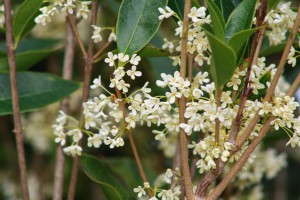
Flowers on Sweet Olive. Photo credit: Julie McConnell, UF/IFAS Extension
Sweet Olive Osmanthus fragrans is a versatile evergreen that produces fragrant flowers from the fall through the winter months. This upright-growing large shrub or small tree has medium green leaves and small white flowers that form in the leaf axils. The tiny flowers are not very showy, but have a light lemony fragrance that will have you searching for the source.
Sweet Olive is not a fast grower but will need space in the garden to reach maturity (15-20 feet tall x 10-15 feet wide). It makes an ideal privacy screen for outdoor living spaces where you can enjoy the flower scents while temperatures are cool.
Sweet Olive will grow in sun or shade, although the foliage is less dense in heavily shaded spots. It performs well in all soil types as long as they are well-drained and once established tolerate drought conditions. Sweet Olive is cold tolerant to zone 7b and has few pests. Although it is in the same family as olives, the fruit is not edible or showy.
To read more about Sweet Olive visit http://edis.ifas.ufl.edu/pdffiles/ST/ST42500.pdf


















